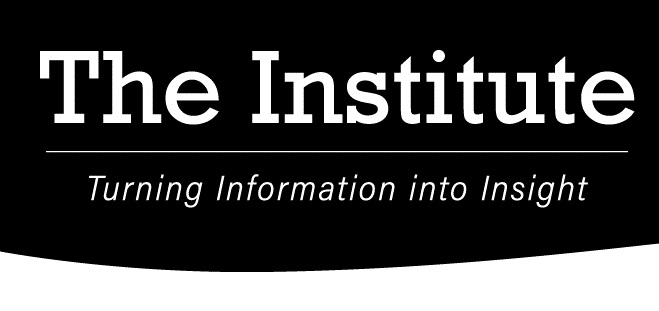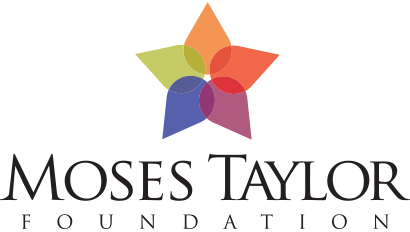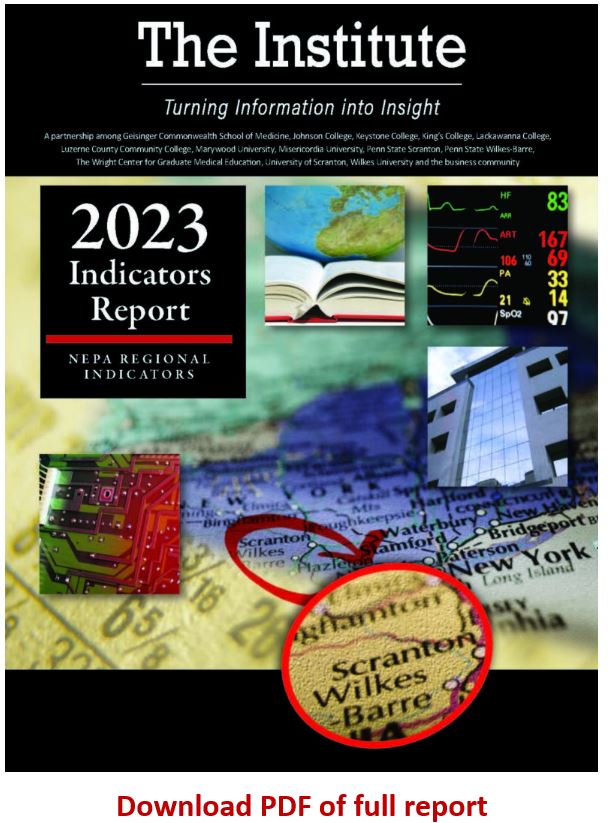Thank You
Thank you to the following organizations for their continued support of our research and this Data Dashboard, which is part of Project STIR (Sparking Transformation using Information & Research).
Early Childhood Education
Keystone STARS is an initiative of the Office of Child Development and Early Learning (OCDEL). It was developed to improve, support, and recognize the continuous quality improvement efforts of early learning programs in Pennsylvania. Participating childcare and early learning programs are rated from one to four stars on several factors, such as teacher quality and adherence to safety regulations.
There has been significant year-to-year fluctuation in the number of participating centers. Lackawanna and Luzerne Counties reached their highest levels in 2021 and the total number of participating facilities remained the same in 2022, with 96 facilities with at least 1 STAR in Lackawanna County and 140 in Luzerne County. Data on Wayne County was not available for prior years, but in 2022 there were 24 facilities with at least 1 STAR. The number of 4-STAR (i.e. highest quality) centers has trended upward in Lackawanna and Luzerne Counties, with a significant increase in 2021. In those two counties, there was a concurrent decrease in STAR 2 and STAR 3 centers, suggesting that those facilities have been graduating to the highest quality level. With 13 facilities, Wayne County had a larger share of 1-STAR centers in 2022, followed by 4-STAR centers with seven facilities.
Keystone STARS Child Care Facilities
Source: Pennsylvania Department of Human Services OCDEL.
Children Living in Poverty
The statewide childhood poverty rate has shown a declining trend over the last few years, from 19.4 percent in 2015 to 16.9 percent in 2021. Provisional data from 2020 showed another sharp decline to 14.4 percent. This was likely driven by additional social spending and emergency safety-net programs put into place during the pandemic. In most years, both Lackawanna and Luzerne Counties have had child poverty rates above the statewide rate. Wayne County had childhood poverty rates below the statewide rate in all years examined. County-level data for 2020 comparable to other years was not available for Lackawanna and Luzerne Counties, but it is likely that the Northeastern Pennsylvania region also saw decreased child poverty because of pandemic interventions. In the case of Luzerne County, 2021 child poverty remains significantly below pre-pandemic levels.
Percent of Children Under 18 Living Below the Poverty Level
Source: U.S. Census Bureau ACS 1-year Estimates. Wayne County data from U.S. Census Bureau ACS 5-year Estimates. 2020 PA data is experimental.
Children in Foster Care
County-level data on children in foster care was sourced from Pennsylvania Partnerships for Children (via the Annie E. Casey Foundation). The most recent data available estimates 1,269 children served by foster care in the three counties in the 12 months ending September 2021. This total includes all individuals aged 0 to 20 years in foster care. This population has slightly increased over the period analyzed, including a year-over-year increase of 43 children in the three-county region. Statewide, 20,490 children were in foster care from October 2020 to September 2021 – a decline of 1,199 children from the previous year.
Both statewide and in the region, racial and ethnic minorities are disproportionately represented in the foster care population. Statewide, nonwhite or Hispanic individuals comprise about one-third of the total population of individuals younger than age 20, but account for 56 percent of the foster care population. In Lackawanna County, nonwhite and/or Hispanic individuals make up 42 percent of children in foster care compared to 27 percent of the total population under age 20. While the number of Hispanic children and youth in foster care in Wayne County was not available, Black individuals made up 15 percent of all children in foster care despite only about 12 percent of the county’s total under 20 population being any race or ethnicity other than White Non-Hispanic. In Luzerne County, the share of nonwhite and/or Hispanic residents under 20 and the share among those in foster care were similar, though there was still a disparity among Black children and youth specifically.
Children in Foster Care
Each one-year period begins in October and ends in September
Source: Pennsylvania Partnerships for Children via the Annie E. Casey Foundation
Number includes all children served in foster care ages 0-20.
Nutrition Assistance
The last decade has generally brought with it a marked increase in the number of households receiving assistance through the Supplemental Nutrition Assistance Program (SNAP, also called food stamps), both regionally and across Pennsylvania. A period of growth occurred from 2010 to 2014, coinciding with changes to program eligibility at the federal level. Further growth in the number of households receiving SNAP was seen from 2015 to 2018; this was more pronounced in Lackawanna and Luzerne Counties than statewide, while Wayne County saw a decline in SNAP utilization. In 2019 and 2020, SNAP usage remained relatively level statewide, at about 13.5 percent of households. It increased to 14.1 percent in 2021. County-level data was not available for 2020, but in 2021, Luzerne County had a lower number and percentage of SNAP recipients compared to 2018 and 2019. Lackawanna County saw an increase in that time. Wayne County’s statistics have recently seen fluctuation without a clear trend.
Households Receiving SNAP (Food Stamps)
Source: U.S. Census Bureau ACS 1-year Estimates
Cash Assistance
Cash assistance programs, such as Temporary Aid to Needy Families (TANF), provide additional income assistance to those who cannot work and to households that do not earn enough from work to support themselves. The number and share of Lackawanna County households receiving cash assistance have fluctuated, but in 2021 reached the lowest point since 2015 and the second lowest since 2012. In Luzerne County, the number of cash assistance recipients increased year over year from 2014 to 2018, before falling in 2019 to the lowest levels seen in the last decade. Luzerne County levels did increase to 3.8 percent in 2020 before dropping to 3.3 percent in 2021. The number of Wayne County households receiving cash assistance fluctuated over the last decade, and most recently the share decreased from 5.4 percent in 2020 to 4.4 percent in 2021.
Households Receiving Cash Assistance
Source: U.S. Census Bureau ACS 1-year Estimates. Wayne County and 2020 data from U.S. Census Bureau ACS 5-year Estimates.
Medical Assistance and CHIP
Since 2011, there has been a substantial increase in the number of individuals eligible for Medical Assistance in the Lackawanna and Luzerne Counties. This growth has been due to expansion of Medicaid under the Affordable Care Act. The percentage of the population and the total number of people eligible for Medical Assistance continued to rise between 2013 and 2018, plateauing in 2018 and 2019 before resuming an upward trend through 2022 – coinciding with expanded eligibility during the COVID-19 pandemic. About one-third of Lackawanna County and Luzerne County residents were eligible for Medical Assistance as of July 2022. Data prior to 2017 was not available for Wayne County, although the number of residents eligible for Medical Assistance rose from 20.4 percent in 2017 to 24.4 percent in 2022.
Statewide enrollment in the Children’s Health Insurance Program (CHIP) grew significantly from 2018 to 2020. CHIP enrollment dropped in Lackawanna and Luzerne Counties and statewide by January 2021, however, and continued to fall through 2023. Even though data from 2018 and 2019 was not available in Wayne County, CHIP enrollment dropped from January 2020 to 2021. Enrollment in Wayne County also decreased from 2021 to 2023. This shift reportedly results from more families using Medicaid due to changes in family income.
Total Persons Eligible for Medical Assistance
Source: Pennsylvania Department of Human Services. Percent of population calculated using previous year’s population estimates from US Census Bureau. Prior years’ data has been updated.
Children’s Health Insurance (CHIP) Enrollment
Data is from January of each year. Source: Pennsylvania Department of Human Services
Programs for Seniors (Population 65 or Older)
The share of seniors (aged 65 or older) among the Lackawanna County population rose from 19.5 percent in 2000 to 20.3 percent in 2021. As of 2021, seniors comprised 19.9 percent of the population in Luzerne County; this is a slightly higher share of the county’s population than in 2000 and a much higher share than 2010. In Wayne County, the share of seniors has increased since 2000, with a substantial growth noted since 2010 at a much higher rate than the other two counties and Pennsylvania. The statewide senior population has similarly trended upward – in 2021, 19 percent of the state population was at least 65 years old (up from 15.6 percent in 2000 and 15.4 percent in 2010). All three counties have typically had higher shares of older residents than the Commonwealth as a whole.
In 2021, there were 25 active adult centers in the three-county region. In Lackawanna and Luzerne Counties, respectively, there are about 0.16 and 0.22 senior centers per 10,000 residents aged 65 years or older. Wayne County has slightly more senior centers on a per-capita basis, with about 0.31 centers per 10,000 residents in this age group.
Population 65 Years and Older
Source: U.S. Census Bureau Population Estimates, 2000 & 2010 U.S. Census
Individuals with Disabilities
In the three counties and statewide, the percentages of individuals with disabilities have fluctuated over the past five years, not accounting for 2020 in Lackawanna and Luzerne Counties when comparable data was not available. In Lackawanna and Luzerne Counties, the proportions of people with at least one disability have been consistently higher than the percentage in the Commonwealth – both counties averaged about 16 percent over the five years analyzed, compared to the statewide five-year average of 14 percent. The five-year estimate for Wayne County is higher still, at 18.3 percent. Of all disabilities reported in the three-county region, 27 percent were ambulatory disabilities, and another 22 percent were cognitive disabilities. Outside those, independent living disabilities were most frequently reported. Hearing, vision, and self-care disabilities each comprise smaller but still substantial amounts of all disabilities reported in the region. This breakdown has changed minimally over the past several years.
Population with a Disability
Source: U.S. Census Bureau ACS 1-year Estimates. 2020 PA data is experimental. Wayne County from U.S. Census Bureau ACS 5-year Estimates.
Tax Credits
Certain tax credits function as a form of social aid to low- and middle-income families and individuals, and play a large role in poverty alleviation. The Earned Income Tax Credit (EITC) is a federal income tax credit that assists lower-income working households. It was received on about one in six Luzerne County tax returns in 2020. In that year, 14.9 percent of returns filed in Lackawanna County received the EITC, as did 12.4 percent of returns in Wayne County. Statewide, 12.8 percent of returns received the EITC. The amount of the credit ranges from $2,000 to $2,100 in the region and statewide. Credits of this amount, when received as tax refunds, can make a significant impact on the financial stability of households. In Lackawanna and Luzerne Counties, the average size of the credit per return has generally grown in the past five years, despite a drop in 2020, while Wayne County showed a nominal increase.
The Child Tax Credit was claimed by about 22 percent of households in Lackawanna and Luzerne Counties in 2020, the same share from the previous year but a slightly smaller percentage than in Pennsylvania as a whole. In 2020, Wayne County saw a decrease from the previous year, with 18.8 percent of households receiving Child Tax Credit – a smaller percentage than the other two counties and statewide, likely due to its differing demographic makeup. The significant increase in households claiming Child Tax Credits between 2017 and 2018, and growth in the average size of the credits, result from expansion of the credit in the Tax Cuts and Jobs Act. The credits ranged from $1,873 in Luzerne County to $2,156 in Lackawanna County. Numbers for all three counties were lower than the state average of $2,213.
Tax Credits – 2020
Source: Internal Revenue Service








 Sarah, a former Institute intern, joined The Institute in April 2021 as a Research Assistant. She started her new role as a Research Analyst in January 2024.
Sarah, a former Institute intern, joined The Institute in April 2021 as a Research Assistant. She started her new role as a Research Analyst in January 2024. 

 Jill Avery-Stoss joined The Institute in June 2018 to fill the newly-created role of Research, Data, Intern & Administrative Coordinator. She assists with the collection and management of data for purposes of ethical and efficient analysis. She visits partner campuses to market The Institute’s internship opportunities, and participates in event-planning logistical activities as well. In 2021, Jill was promoted to Director of Operations to reflect the diversity in her job description and the additional marketing and communication functions she successfully mastered in 2020. In 2022, Jill was named Chief Operating Officer after expanding into both research and administrative management functions. Jill is taking on project management, fundraising, and other executive leadership functions of the organization.
Jill Avery-Stoss joined The Institute in June 2018 to fill the newly-created role of Research, Data, Intern & Administrative Coordinator. She assists with the collection and management of data for purposes of ethical and efficient analysis. She visits partner campuses to market The Institute’s internship opportunities, and participates in event-planning logistical activities as well. In 2021, Jill was promoted to Director of Operations to reflect the diversity in her job description and the additional marketing and communication functions she successfully mastered in 2020. In 2022, Jill was named Chief Operating Officer after expanding into both research and administrative management functions. Jill is taking on project management, fundraising, and other executive leadership functions of the organization. Ooms is responsible for all facets of research, organizational strategy, and management. Ooms is an active principal investigator in all Institute research. Ooms has been nationally recognized as a leader in regional economic development. She turned that skill into a research institute to help other regions develop and prosper. Her strategic skills have allowed The Institute to expand its services to the private and non-profit sectors for research and analysis in community health needs assessments, strategic planning, market and feasibility studies, and economic impact analysis.
Ooms is responsible for all facets of research, organizational strategy, and management. Ooms is an active principal investigator in all Institute research. Ooms has been nationally recognized as a leader in regional economic development. She turned that skill into a research institute to help other regions develop and prosper. Her strategic skills have allowed The Institute to expand its services to the private and non-profit sectors for research and analysis in community health needs assessments, strategic planning, market and feasibility studies, and economic impact analysis.